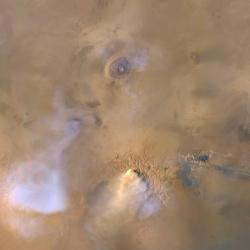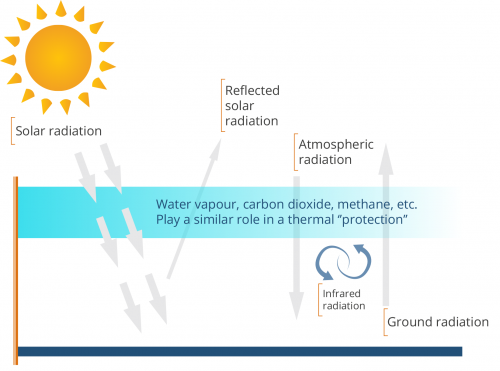A natural phenomenon on Earth
The greenhouse effect is a natural phenomenon that makes Earth suitable for life as we know it. Without the greenhouse effect the average temperature on Earth would be -18°C instead of the mild 13 to 15°C as exists today.
Most of the energy that the Sun radiates is in the form of visible light and near-visible (ultraviolet and infrared) radiation. About two thirds of the incoming solar radiation heats the surface of the Earth system (i.e. the surface and the atmosphere), while the remaining third is reflected back to space by the atmosphere (in particular the clouds) and by the surface (in particular, snow and ice).
The absorbed light is transformed into heat and re-emitted in the form of invisible infrared radiation. This radiation partly escapes the Earth’s system, but an important fraction is absorbed by molecules in the atmosphere. The heat absorbed by these gases is re-emitted in all directions.
These molecules are “greenhouse gases”:
- Water vapour
- CO2 (carbon dioxide)
- CH4 (methane)
- N2O (nitrogenoxide)
- O3 (ozone)
- CFCs (chlorofluorocarbons)
They are called like that because, like the glass walls of a greenhouse, they prevent a fraction of the accumulated energy to escape rapidly from the system. The energy budget between the incoming and outgoing rays must be conserved, causing the temperature to rise in the lower atmosphere.
The greenhouse effect: certainties and studies on this topic
Silent signatures witnessing the Earth’s former atmospheres, air bubbles found in ice layers (Antarctica and Greenland), dating back to the ice age, provide useful information concerning the Earth’s atmosphere in the past. Analyzing these air bubbles scientists can reconstruct the evolution of atmospheric components such as CO2 and CH4.
The evolution of temperature has been observed to be strongly correlated with the concentrations of these chemical components. This suggests that the climate and the composition of the atmosphere are closely related, although for the precise causal connection between the two has not been completed elucidated yet. However, the fact that there has never been so much carbon dioxide and methane in the atmosphere as there is today is certainly a cause for concern.
The greenhouse effect: enhanced by human activity
The origin of some greenhouse gases in the atmosphere, especially water vapor, but also CO2 , CH4, N2O, ozone (O3), is partly natural.
Human activities, though, have considerably enhanced the concentration of some components, such as:
- CO2
- CH4
- N2O
They have caused the production of new components in the atmosphere, such as chlorofluorocarbons. Their amount is rapidly increasing and therefore worrisome for the future – global warming.
Global efforts to combat global warming
The United Nations Framework Convention on Climate Change has been the centerpiece of global efforts to combat global warming since it was adopted at the Earth Summit in Rio de Janeiro in 1992 and has resulted into the 1997 Kyoto Protocol.


